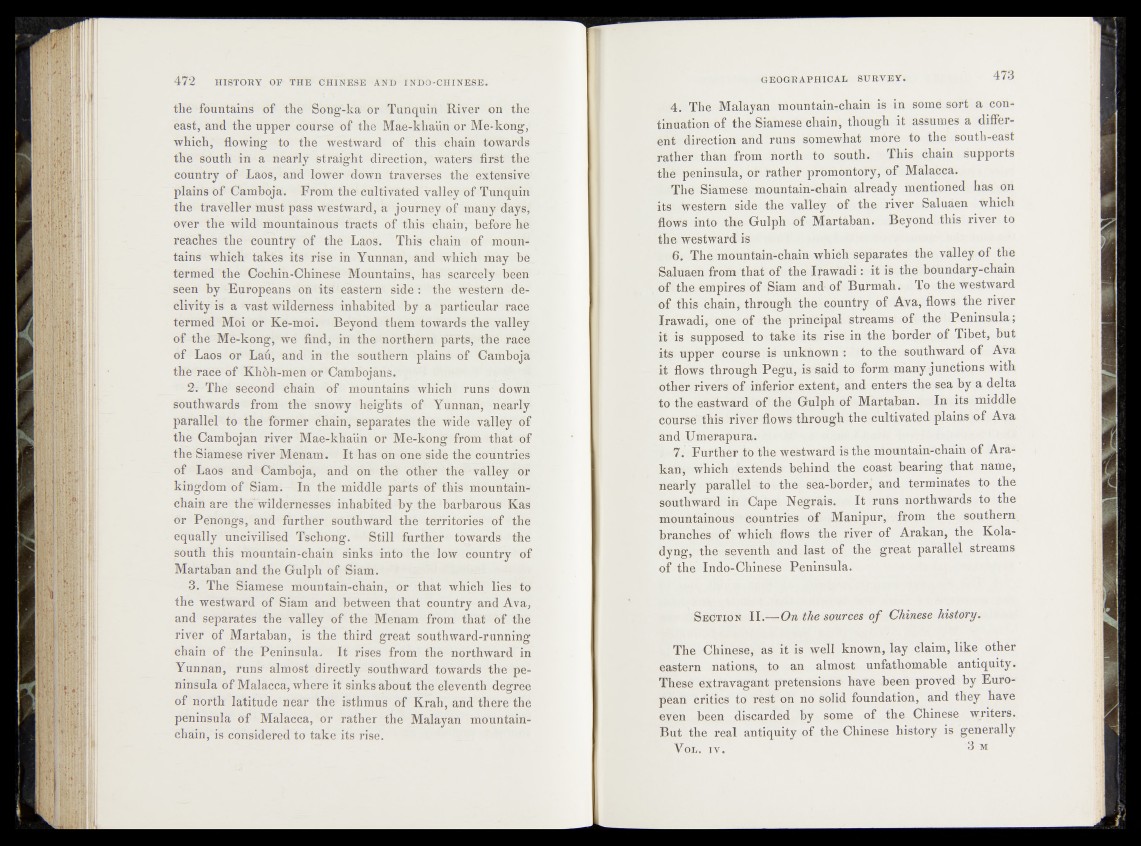
thefountams of the Song-ka or Tun quin River on the
east, and the upper course- of the Mae-kh&ün orMe-kong,
which,’' flowing to the westward of this chain towards
the south in a nearly straight direction, waters first the
country of Laos, and lower down traverses th e ‘extensive
plains of Camboja. From the cultivated valley of Tunqüin
the traveller must pass Westward, a journey of many days,
over the wild mountainous tracts of this chainy before he
reaches the country of the Laos. This chain of modttft
tains which takes its rise in Yunnan, and which may be„
termed the Cochin-Chinese Mountains, has scarcel'ybeèh
seen by -Europeans on its'I eastern side: ?th% western declivity
is a vast wilderness inhabited by a particular race
termed Mói or Ke-moi. Beyond them towards the valley
of the Me-kong, we find, in the northern5 parts, the race
of Laos or Laü, and in the southern plains of CUmboja
the race of Khöh-men or Cambojans, ,
2 ;-The second chain of mountains wMcp runs "down
southwards from the snowy heights of Yunnan, nöèrly
parallel to thé former chain, separates the widë^-valley^ Of
the Cambojan river Mae-kha'iin or Me-kong from that of
the Siamese river Menam. It has on one Side the'countries
of Laos and Camboja, and on the other the valley or
kingdom of Siam. In the middle parts of this-mountain-
chain are the“wildernesses inhabited by the llffltbirOUS Ma#
or Penongs, and further southward the territories of* the
equally uncivilised Tschong. Still further- towards the
south this mountain-chain sinks into the low country of
Martaban and the Gulph of Siam.
3. The Siamese mountain-chain, or that which lies to
the westward of Siam and between that country and Ava,
and separates the valley of the Menam from that of the
river of Martaban, is the third great southward-running
chain of the Peninsula., It rises from the northward in
Yunnan, runs almost directly southward towards the peninsula
of Malacca, where it sinks about the eleventh degree
of north latitude near the isthmus of Krah, and there the
peninsula of Malacca, or rather the Malayan mountain-
chain, is considered to take its rise.
4. The Malayan mountain-chain is in some sort a continuation
of the Siamese chain, though it assumes a different
direction and runs somewhat more to the south-east
rather than from north to south. This chain supports
thMjiWipWa, or rather promontory, of Malacca.
The Siamese mountain-chain already mentioned has on
its Western side the valley of the river Saluaen which
flows into the Gulph of Martaban. Beyond this river to
the westward is
6. The mountain-chain which separates the valley of the
Saluaen from that of the irawadi is the boundary-chain
of the empires of Siam and* of Burmah. To the westward
o f this chain, through the country of Ava, flows the river
Irawadi, one of the principal streams of the Peninsula;
it is supposed to take its rise in the border of Tibet, but
its upper course is unknown : to the; southward of AVa
it flows through Pegu, is said to form many junctions with
other rivers of inferior extent, and enters the sea by a delta
to^ie eastward of the Gulph of Martaban. In its middle
course this river flows through the cultivated plains of Ava
and Umerapura,
- 7. Further to the westward is the mountain-chain of Ara-
kan, which extends behind the coast bearing that name,
nearly ■ parallel to the sea-border,’ and terminates to the
southward in Cape Negrais. It runs northwards to the
mountainous Countries of Manipur, from the southern
branches of which flows the river of Arakan, the Kola-
dyng, the seventh and last of the great parallel streams
of the Indo-Chinese Peninsula.
S ection II .—On the sources of Chinese history.
The Chinese, as it is well known, lay claim, like other
eastern nations, to an almost unfathomable antiquity.
These extravagant pretensions have been proved by European
critics to rest on no Solid foundation, and they have
even been discarded by some of the Chinese writers.
But the real antiquity of the Chinese history is generally
Vol. iv. 3 M